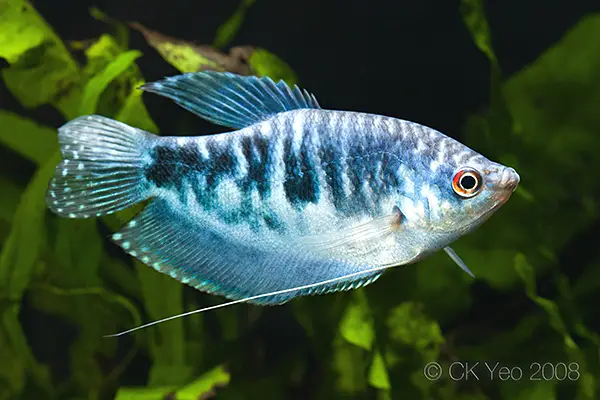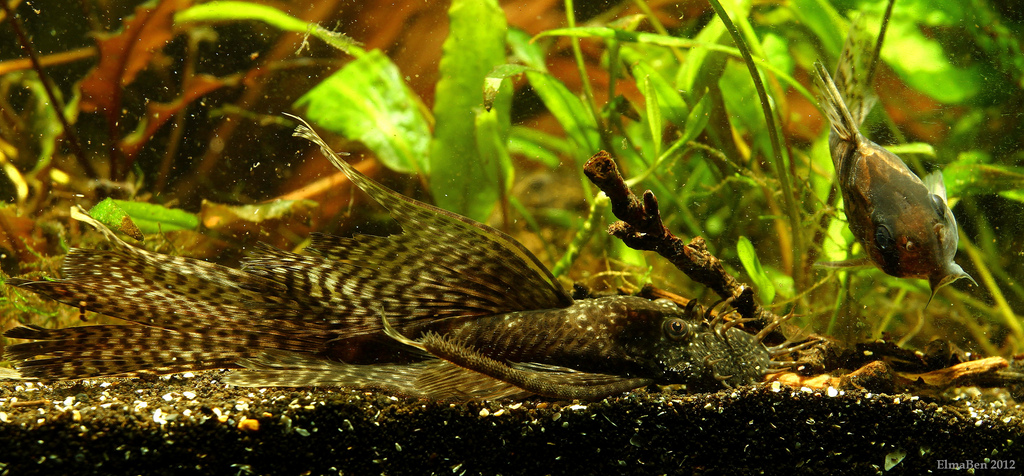 |
| Junior Gorski's very attractive, very large African Cichlid tank. Aquahobby's July '12 tank of the month. |
Today we'll be talking about designing stocking lists for freshwater community aquariums - that is, ordinary aquariums of the household variety, containing more than one species of fish. There's an awful lot of thought on the subject, and I've seen everything from united-nations like assemblies of fish from the world over to small, painstakingly-crafted slices of the amazon (the latter is a special sort of tank I'll get to at the end).
As always, research is key, and I point hobbyists to seriouslyfish.com and aquahobby.com for their extensive listing of fish care sheets. There are, however, a few generalities I've picked up that aren't immediately obvious from care sheets, which I wanted to share.
Law of Shared Space
One of the things you'll notice on Seriously Fish's care sheets is that the tank capacity required for an ordinary group (or sometimes a single) fish of that species is always given. It is important to note that the fish in question does not need that much space all unto itself (or themselves), but that this is the appropriate amount of space for them to get the right amount of activity to reach adult size and still be comfortable in their environment.
With exceptions made for notedly solitary fish (which aren't suitable to the community tank), this space can still be shared. At that point, the hard limit becomes more a study in filtration capacity. As a general rule, once tank size requirements are met, I allow one square-inch of fish surface area per gallon. Usually, though, the fish will so signs of stress when overcrowded. Use your own best judgement.
Law of Gradient
Different fish occupy different depths in the tank. Loricariidae and corydoras catfish, for example, prefer to be closer to the bottom, as do many species of barb. By comparison, stately gouramis prefer to occupy the area near the surface. Plenty of fish prefer the middle. The Law of Gradient is an adjunct to the Law of Shared Space that specifies the law most applies to cases where fish sharing an overlap in tank capacity occupy different depths. The design equivalent of the Law of Gradient is the Pesciphile Law of Thirds which states that an odd number of species should occupy each of the top, middle, and bottom depth slots.
Step One: Feature Fish
A feature fish is a fish, often a single specimen, intended to be the focus of the tank. In many, but not all cases, it is a larger, visually-striking focal-fish, such as an angel, discus, or larger-species gourami. Feature fish are a common feature in increasingly-larger tank size categories because they catch the eye and bring attention in for the smaller fish that they cohabit.
Since the feature fish is often a favourite, almost always getting named, and frequently the focus of the owner's affection, I usually advise people to start selecting their tank stock based on that one feature fish.
Step Two: Apply Bounds
My favourite tool for making stock lists is a digital spreadsheet (I use Microsoft Excel, to the chagrin of my linux/open-source circle of friends) - a template can be found here. The reason for that is that combining fish makes the acceptable water condition balance more and more specific with each new species you add. Essentially, the tank's pH and Hardness should be as close to the middle of the overlap of the range of all the fish as possible.
If you picture each range as overlapping lines, you want to be as close to the middle of the segment where every range overlaps as possible. In general, this is not difficult to do, though a few species will make it difficult.
Step Three: Introduction
I introduce fish according to size and numbers. I try never to introduce more than a half-dozen fish at a time to give the tank time to adjust to their bioload, and I start with the smallest first, which is more a matter of preference than anything. Always acclimate fish to your new tank conditions and always keep an eye on new fish for undue aggression or stress. I advise people who have the room to have a second tank available as a quarantine, and to introduce new fish only after the quarantine fish have been shown healthy for a few days. Where I work, we do a pretty good job of quarantining sick fish ourselves, but we're not always perfect, and an ounce of prevention is worth a pound of cure.
On Utility Fish
There are a few fish that seem doomed to be kept in inhospitable conditions - the loricarridae - specifically because they are known to eat awfuchs, the buildup of algae and biofilm on glass and tank contents that many consider unsightly. The Loricarids are particularly popular for this purpose, supposedly because they are among the only species to clean glass itself. Unfortunately, your average aquarist doesn't have the tank capacity to care for one of these fish properly, and so these fish wind up being stunted and die prematurely.
For those with very small tanks I recommend snails as the most effective and simplest-kept solution for cleaning glass. If you're anything like me, though, snails are about as boring as they come, breed too easily, and are too difficult to be rid of. If you absolutely must insist on using a fish in a smaller (sub-0 gallon) tank in the role of an "algae-eater", focus on Otocinculus spp. (the so-called "midget suckermouth catfishes") or Ancistrus spp. (the Bristle-Nose Plecos). These are fish that stay small naturally, eat awfuchs voraciously, and are much better suited to small tanks.
Establishing a Theme
When I go for a theme, I usually go for contrasting colours, though an increasingly popular (and, in my opinion, much nicer) trend is to build a biotope aquarium. A biotope as closely resembles the conditions of a given body of water as much as humanly possible - Amazonian is a popular example. Biotope tanks are a challenge, because sourcing aquatic plants endemic to a specific region is much harder than selecting fish. It is, however, considered rewarding by many.
In point of fact, I know of a few species of fish that can only be kept safely in conditions so specific as to force the owner to create a biotope tank for them. These are all very visually-interesting fish as well, and it's an option worth considering.


No comments:
Post a Comment